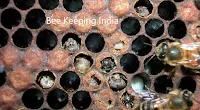Introduction:
Within the intricate world of beekeeping, one phenomenon that captivates researchers and beekeepers alike is the process of larval desiccation in Apis mellifera bee hives. This unique and fascinating behavior, displayed by these industrious honey bees, plays a vital role in the survival and health of the colony. In this blog post, we will delve into the reasons why larva becomes dry in Apis mellifera bee hives and explore the significance of this behavior in maintaining a thriving bee community.
The Purpose of Larval Desiccation:
Apis mellifera bees, also known as Western honey bees, have evolved an ingenious strategy to combat diseases and ensure the survival of their offspring. Larval desiccation is a remarkable behavior wherein worker bees intentionally remove moisture from the brood cells containing developing larvae.
By reducing the humidity around the larvae, the bees create an inhospitable environment for pathogens and parasites. Many harmful microorganisms that threaten the health of the hive require a moist environment to thrive. By desiccating the larvae's surroundings, the worker bees effectively limit the spread of diseases, ultimately safeguarding the colony's well-being.
How Larval Desiccation Works:
The process of larval desiccation begins soon after the queen bee lays her eggs in the brood cells. Worker bees promptly cap the cells with wax, enclosing the growing larvae inside. These worker bees then deploy their wings to generate airflow within the hive. This circulation of air aids in the evaporation of moisture from the surrounding environment, thereby drying out the larvae's cells.
Furthermore, the worker bees continuously monitor the humidity levels inside the hive and adjust their ventilation efforts accordingly. This remarkable ability to regulate humidity serves as an essential defense mechanism, thwarting the proliferation of harmful pathogens and preserving the colony's health.
The Role of Hygienic Behavior:
The practice of larval desiccation is crucial behavior known as hygienic behavior. Apis mellifera bees exhibit an innate hygienic trait, which enables them to identify and remove brood that is infected or deceased. This diligent housekeeping reduces the risk of contagious diseases spreading within the colony.
When the worker bees detect an infected larva, they promptly remove it from the hive, preventing the harmful agents from affecting others. However, in some cases, worker bees may not be able to identify the exact pathogens present. In such instances, the general strategy of larval desiccation acts as a safeguard, ensuring that the environment remains unsuitable for pathogen proliferation, even if the bees cannot pinpoint the specific threat.
Conclusion:
The marvel of larval desiccation in Apis mellifera bee hives exemplifies the ingenuity and adaptability of these remarkable creatures. Through this unique behavior, worker bees actively protect their young from the perils of disease, preserving the integrity of the entire colony.
Larval desiccation, in conjunction with other hygienic behaviors, forms a crucial defense system, allowing Apis mellifera bees to thrive and maintain their essential role as pollinators and honey producers. As we continue to study and appreciate the intricate workings of these tiny yet vital insects, we gain a deeper understanding of the delicate balance that sustains life within the bee hive.

